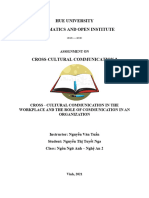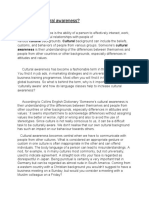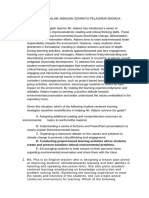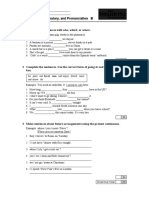Presentation Speech
Presentation Speech
Uploaded by
tzenin22Copyright:
Available Formats
Presentation Speech
Presentation Speech
Uploaded by
tzenin22Copyright
Available Formats
Share this document
Did you find this document useful?
Is this content inappropriate?
Copyright:
Available Formats
Presentation Speech
Presentation Speech
Uploaded by
tzenin22Copyright:
Available Formats
Strategies & Recommendations
At Global Visions, we recommend implementing thorough methods to address this
issue, ensuring that the employees succeed and are happy in their international roles.
Firstly, we focus on pre-departure preparations. This includes providing cultural
awareness training, offering engaging seminars on the traditions, business procedures,
and culture of the host nation. We also emphasize cross-cultural competence
development, helping employees become more adept at adjusting to various cultural
circumstances. Briefings tailored to each country provide comprehensive details about
the politics, economy, history, and social structure of the host nation. Additionally, our
family support services assist employees' families in being ready for the challenges of
adjusting to life in a foreign country.
During the experience, we offer ongoing support through frequent check-ins with
expatriates to handle any problems or worries they might have. Conflict-resolution
training should also be provided to help employees resolve disputes that may result
from cultural misunderstandings. We encourage cultural immersion by providing
opportunities for employees to take part in regional cultural events, activities, and
customs. Language support is also offered to help foreign nationals become more
fluent in the local language.
For re-entry support, we recommend reverse culture shock training to help staff
members adjust to their native environment. Knowledge sharing sessions are
encouraged to foster cross-cultural communication and knowledge acquisition within
the company. We also suggest career development planning, outlining the abilities and
perspectives acquired from the assignment and offering advice on how staff members
can use their foreign experience to develop their careers within the company.
the communication plan emphasizes transparent communication, explaining the
purpose of the cultural training course and the advantages it provides to the
organization and its personnel. We advise engagement with stakeholders to ensure that
the training program satisfies their requirements and expectations. Finally, it is essential
to celebrate accomplishments by showcasing staff members who have successfully
handled cultural shock, demonstrating the value of the training initiative.
Strategies for Communication
I want to talk to you about the importance of understanding cultural differences in
communication for fostering cultural competence in the workplace. Communication is
not just about the words we use; it's also about understanding the nuances of language,
nonverbal cues, and cultural norms. These factors play a crucial role in how we interact
with others, especially in diverse and multicultural environments.
One of the key aspects of communication across cultures is language. Different
cultures have different languages, each with its own set of rules and conventions.
Translating words directly from one language to another may not convey the intended
meaning accurately. It's essential to be aware of these differences and use language
appropriately to avoid misunderstandings.
Nonverbal communication is another important factor to consider. Nonverbal cues
such as facial expressions, gestures, and body language can vary widely across
cultures. For example, in some cultures, direct eye contact is a sign of respect and
attentiveness, while in others, it may be considered rude or confrontational.
Understanding these differences can help us interpret the messages others are trying to
convey and respond appropriately.
Context and indirectness are also critical aspects of communication in different
cultures. Some cultures prefer explicit and direct communication, while others value
indirectness and rely on context and implied meanings. Being able to navigate these
differences can help us communicate more effectively with colleagues from diverse
backgrounds.
Hierarchy and formality are important considerations as well. Cultural norms around
hierarchy can influence communication styles, with some cultures emphasizing strict
adherence to hierarchical structures, while others have more egalitarian
communication styles. Understanding these dynamics can help us navigate
interactions with colleagues at different levels of the organization.
Listening and feedback are also important aspects of communication across cultures.
The importance of active listening and providing feedback can vary across cultures, with
some cultures valuing immediate feedback and others preferring to listen quietly and
provide feedback later. Being aware of these differences can help us communicate
more effectively with colleagues from diverse backgrounds.
In conclusion, understanding cultural differences in communication is crucial for
fostering cultural competence in the workplace.
Pre-Assessment
High context cultures:
Relies heavily on implicit communication, such as body language, context, and
relationships.
Places a high value on relationships and group harmony.
Like: Asian, Middle Eastern, and Latin American
Low context cultures:
Relies more on explicit communication, with messages being conveyed through words
rather than context.
Places more emphasis on individualism and directness.
Like: North American, Northern European cultures.
Collectivist and Individualist:
Collectivist culture prioritize the group over the individual, emphasizing harmony,
cooperation, and loyalty.
Individualist cultures prioritize personal goals, autonomy, and self-expression.
Culture Shock:
The feeling of discomfort when you are in an unfamiliar cultural environment. It occurs
when you encounter a way of life, behaviours, or beliefs that are different from your
own. There are typically four stages of cultural shock:
Honeymoon stage: In this stage, everything is new and exciting. You may feel euphoric
and fascinated by the new culture. You might find the differences charming and enjoy
exploring them.
Crisis or Negotiation stage: As you start to settle into the new culture, you may start to
notice more differences that could lead to frustration or anxiety. Experiencing
homesickness or adapting becomes difficult.
Acceptance stage: you start to accept the new culture and try to get comfortable with
and accept the differences, developing strategies to cope with them.
Adaptation stage: In the final stage, you have fully adapted to the new culture. You feel
at home and comfortable in the new environment.
Many of us can relate to all this most of these stages if not all since we have moved to a
different country with a diverse culture.
You might also like
- Intercultural RelationsDocument27 pagesIntercultural RelationsHari88% (17)
- User Interface Designer Book-1Document520 pagesUser Interface Designer Book-1parkermassingNo ratings yet
- Communication Challenges in Multi - Cultural OrganizationsDocument6 pagesCommunication Challenges in Multi - Cultural OrganizationsArupuda RajanNo ratings yet
- TranslationDocument67 pagesTranslationAldus Furens100% (3)
- Cross Culture ModuleDocument7 pagesCross Culture ModuleChetan NarkhedeNo ratings yet
- Purposive-Communication-Reporting Group 1Document17 pagesPurposive-Communication-Reporting Group 1Jommel TejereroNo ratings yet
- Cross CulturalDocument17 pagesCross CulturalAparna HemanthNo ratings yet
- Chpter 1Document5 pagesChpter 1topaneh316No ratings yet
- Business Communication AssignmentDocument19 pagesBusiness Communication AssignmentOmar FarukNo ratings yet
- Cross CC TbsDocument17 pagesCross CC TbsAkshyath GuptaNo ratings yet
- Opportunities and Challenges of Communication in A Diverse WorldDocument14 pagesOpportunities and Challenges of Communication in A Diverse Worldsuraj lamaNo ratings yet
- Purposive Communication ReportingDocument14 pagesPurposive Communication ReportingJommel TejereroNo ratings yet
- Intercultural CommunicationDocument4 pagesIntercultural CommunicationlilychengmiNo ratings yet
- Business Communication 240522 175359Document22 pagesBusiness Communication 240522 175359Showrov BaruaNo ratings yet
- Unit 5 Crisis Reading MaterialDocument14 pagesUnit 5 Crisis Reading MaterialckelaskarNo ratings yet
- Assignment LINDocument4 pagesAssignment LINMeimon Sanai100% (1)
- Overcoming Cross Cultural Communication BarriersDocument41 pagesOvercoming Cross Cultural Communication Barriersakia29112No ratings yet
- Eka Junita Darya NingsihDocument9 pagesEka Junita Darya NingsihEka Junita Darya NingsihNo ratings yet
- Unit III Cross Cultural CommunicationDocument22 pagesUnit III Cross Cultural CommunicationVarun GoheNo ratings yet
- Purposive Communication Report Lesson 2Document10 pagesPurposive Communication Report Lesson 2202202214No ratings yet
- Cross Culture Management: Assignment-2Document11 pagesCross Culture Management: Assignment-2Varun NandaNo ratings yet
- Cross Cultural CommunicationDocument9 pagesCross Cultural CommunicationIndra Bahadur SinghNo ratings yet
- DocumentDocument10 pagesDocumentCorine Cometa ColorNo ratings yet
- Cultural Variable and CommunicationDocument5 pagesCultural Variable and CommunicationarshiaNo ratings yet
- English of Business s3 c2.3.4.5.6Document18 pagesEnglish of Business s3 c2.3.4.5.6baazizlamis7No ratings yet
- 2023 Module 3 P.CDocument17 pages2023 Module 3 P.CPrinces Gado LuarcaNo ratings yet
- EFB Relection PaperDocument6 pagesEFB Relection PaperAdolf AgieNo ratings yet
- Communicating Across CulturesDocument6 pagesCommunicating Across CulturesArun Kumar100% (1)
- Cross Cultural Communication ThesisDocument5 pagesCross Cultural Communication Thesisnorahernandezpeoria100% (2)
- Cross Culture CommunicationDocument19 pagesCross Culture CommunicationYash DaveNo ratings yet
- CCC MnotesDocument6 pagesCCC MnotesTino AlappatNo ratings yet
- Cultural Challenges in International BusinessDocument11 pagesCultural Challenges in International BusinessCarlo Alancado100% (1)
- Nguyễn Thị Tuyết Nga - Giao Thoa Văn Hóa 2 - Nghệ an 2Document14 pagesNguyễn Thị Tuyết Nga - Giao Thoa Văn Hóa 2 - Nghệ an 2HoàiThương NguyễnNo ratings yet
- 2 Im Learning Activities General Instructions: Encode or Write Your Assignment On A 13' X 8.5' Size of Paper. Follow TheDocument4 pages2 Im Learning Activities General Instructions: Encode or Write Your Assignment On A 13' X 8.5' Size of Paper. Follow TheCatherine Grospe GinesNo ratings yet
- Local and Global Communication in Multicultural SettingsDocument18 pagesLocal and Global Communication in Multicultural SettingsIvan SanielNo ratings yet
- Cross Cultural Communication AssignmentDocument6 pagesCross Cultural Communication AssignmentareeNo ratings yet
- Intercultural CommDocument23 pagesIntercultural CommJoyce NucumNo ratings yet
- Cross Cultural CommunicationDocument10 pagesCross Cultural CommunicationDherya PatelNo ratings yet
- Cultural Interpersonal ConflictsDocument2 pagesCultural Interpersonal Conflictstuanlahs186019No ratings yet
- Chapter 5 Cultural Diversity IssuesDocument9 pagesChapter 5 Cultural Diversity Issuesnur atikahNo ratings yet
- What Is Crosscultural CommunicationDocument3 pagesWhat Is Crosscultural CommunicationMarch Dequi�ANo ratings yet
- Communication Challenges in A Multicultural OrganizationDocument9 pagesCommunication Challenges in A Multicultural OrganizationEllah MoniqueNo ratings yet
- Cultural Awareness SkillsDocument7 pagesCultural Awareness SkillsMary Christine IgnacioNo ratings yet
- Multicultural Orietation-1Document8 pagesMulticultural Orietation-1Twain AntonyNo ratings yet
- Issues That Cause ConflictDocument2 pagesIssues That Cause Conflictأحمد حمادNo ratings yet
- Advantages and Disadvantages of Studying Abroad AdvantagesDocument6 pagesAdvantages and Disadvantages of Studying Abroad Advantagesgiangdtc22410No ratings yet
- Submitted To Maam SimalDocument9 pagesSubmitted To Maam SimalHamza ShafiqNo ratings yet
- Objectives: Barriers in Effective Cultural Communication in BusinessDocument9 pagesObjectives: Barriers in Effective Cultural Communication in BusinessBala RajNo ratings yet
- Cultural Communication Barriers in The WorkplaceDocument4 pagesCultural Communication Barriers in The WorkplaceHoroba DanielNo ratings yet
- Lecture 3 Cultural CompetenceDocument13 pagesLecture 3 Cultural CompetenceMỹ Dung Lê TườngNo ratings yet
- IBNMOD2Document16 pagesIBNMOD2divyaNo ratings yet
- Culture Hofstede DimensonsDocument5 pagesCulture Hofstede DimensonsManuela ArévaloNo ratings yet
- Business Communication NotesDocument8 pagesBusiness Communication NotesTehreem JunaidNo ratings yet
- Businees Communication 3Document4 pagesBusinees Communication 3cadeyare1201No ratings yet
- ScriptDocument7 pagesScriptselimabdelrahman989No ratings yet
- Asyncronous Activity Monday and Tuesday ClassesDocument2 pagesAsyncronous Activity Monday and Tuesday Classespau mejaresNo ratings yet
- Chapter 2 Part 3Document16 pagesChapter 2 Part 3gian reyesNo ratings yet
- OPMANDocument6 pagesOPMANSheri IsraelNo ratings yet
- How Culture and Communication Impact Multicultural Global TeamsDocument4 pagesHow Culture and Communication Impact Multicultural Global TeamsHaruichi KominatoNo ratings yet
- Chapter 2 Purposive CommDocument19 pagesChapter 2 Purposive CommcosmicNo ratings yet
- Intercultural CommunicationDocument7 pagesIntercultural CommunicationReynalyn HernaizNo ratings yet
- Class 8 - Third Periodic Test Portion-2021-22Document4 pagesClass 8 - Third Periodic Test Portion-2021-22krishshanthbNo ratings yet
- Delhi Public School Surat: Class Viii Periodic Assessment-IiDocument3 pagesDelhi Public School Surat: Class Viii Periodic Assessment-IiC-0319-16 SHREYANS R MALLNo ratings yet
- Early Literacy: Perkins Panda: Tom Miller Educational Partnerships Program Perkins School For The BlindDocument36 pagesEarly Literacy: Perkins Panda: Tom Miller Educational Partnerships Program Perkins School For The BlindJOHN CAYLE DEVILLANo ratings yet
- Skema E Vlerësimit Gjuhë Angleze (Niveli B2) Varianti A: Reading ComprehensionDocument4 pagesSkema E Vlerësimit Gjuhë Angleze (Niveli B2) Varianti A: Reading ComprehensionXhoana PohumiNo ratings yet
- Module 1-2 - Teaching & Assessment of The Macro SkillsDocument11 pagesModule 1-2 - Teaching & Assessment of The Macro SkillsMay Ann SalamanesNo ratings yet
- Types of Media (Print, Broadcast, New Media)Document55 pagesTypes of Media (Print, Broadcast, New Media)May LanadaNo ratings yet
- Technical English 2e L1 - Teachers GSE MappingDocument19 pagesTechnical English 2e L1 - Teachers GSE MappingCynthia SoledadNo ratings yet
- A Social Science Perspectives On How Critical Reading Skills Be Applied On Media Digital Information From Indonesian ContextDocument7 pagesA Social Science Perspectives On How Critical Reading Skills Be Applied On Media Digital Information From Indonesian ContextInternational Journal of Innovative Science and Research TechnologyNo ratings yet
- The Communicative Approach To Language Teaching in The ClassroomDocument16 pagesThe Communicative Approach To Language Teaching in The ClassroomDanielGuerrero14No ratings yet
- Com3703 Marking Rubric - Assignment 1 (2022) Jadie-Lee Moodly - 66292727Document5 pagesCom3703 Marking Rubric - Assignment 1 (2022) Jadie-Lee Moodly - 66292727jadie leeNo ratings yet
- Activity 21stDocument1 pageActivity 21stKhafzael VlazdemorNo ratings yet
- Week 7 Year 2 English Lesson PlanDocument2 pagesWeek 7 Year 2 English Lesson PlanNyakwar Leoh NyabayaNo ratings yet
- Emergent Reader and Emergent WriterDocument24 pagesEmergent Reader and Emergent WriterAnwar MokalamNo ratings yet
- MMT Young Turks' Business Challenge Online PDFDocument9 pagesMMT Young Turks' Business Challenge Online PDFShruti indurkarNo ratings yet
- Communicative Styles: Quarter 1 Week 3 (English 9)Document14 pagesCommunicative Styles: Quarter 1 Week 3 (English 9)Ailel Suzzet del RosarioNo ratings yet
- Intro To World ReligionsDocument4 pagesIntro To World ReligionsChristyl Jane MontenegroNo ratings yet
- CAdriano ProcessRecording NSG3137Document8 pagesCAdriano ProcessRecording NSG3137Camile LouiseNo ratings yet
- Paraphrasing, Summarising & QuotingDocument32 pagesParaphrasing, Summarising & Quotingfaruk9042650522No ratings yet
- Verbal and Non-Verbal CommunicationDocument30 pagesVerbal and Non-Verbal CommunicationTiffany SelirioNo ratings yet
- Week 41Document9 pagesWeek 41Muhamad SolihinNo ratings yet
- Integrating Curriculum 2Document21 pagesIntegrating Curriculum 2aireshane.parconNo ratings yet
- Soal Try Out PPG Dalam Jabagan 2024mata Pelajaran Bahasa InggrisDocument17 pagesSoal Try Out PPG Dalam Jabagan 2024mata Pelajaran Bahasa InggrisChiko HayaleNo ratings yet
- Week 27 - Unit 9 at The BeachDocument5 pagesWeek 27 - Unit 9 at The BeachSEGARAN A/L SINATHAMBY KPM-GuruNo ratings yet
- Advocacy of The Eclectic Approach To ESL/EFL Teaching in BangladeshDocument9 pagesAdvocacy of The Eclectic Approach To ESL/EFL Teaching in BangladeshburhanNo ratings yet
- 3 Grammar, Vocabulary, and Pronunciation B: Grammar 1 Complete The Sentences With Who, Which, or WhereDocument6 pages3 Grammar, Vocabulary, and Pronunciation B: Grammar 1 Complete The Sentences With Who, Which, or WherePolinaNo ratings yet
- Controversial Phonics Questions AnsweredDocument14 pagesControversial Phonics Questions AnsweredSamuel TomNo ratings yet
- Take A Look at My Canva DesignDocument12 pagesTake A Look at My Canva DesignRogelyn Morales PosadasNo ratings yet
- Unit 2 Brief NotesDocument10 pagesUnit 2 Brief NotesAnshul AryaNo ratings yet

























































































